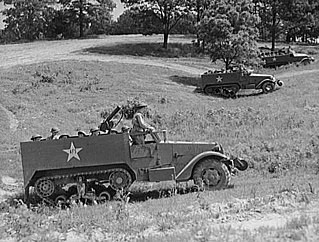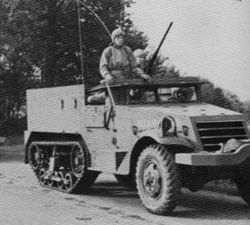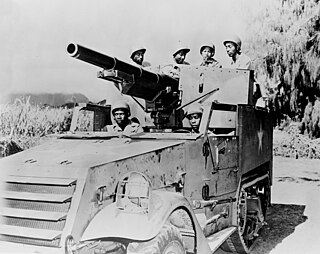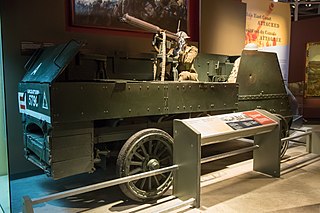
An armoured fighting vehicle or armored fighting vehicle (AFV) is an armed combat vehicle protected by armour, generally combining operational mobility with offensive and defensive capabilities. AFVs can be wheeled or tracked. Examples of AFVs are tanks, armoured cars, assault guns, self-propelled artilleries, infantry fighting vehicles (IFV), and armoured personnel carriers (APC).

A tank destroyer, tank hunter or tank killer is a type of armoured fighting vehicle, predominantly intended for anti-tank duties. They are typically armed with a direct fire artillery gun, also known as a self-propelled anti-tank gun, or missile launcher, also called an anti-tank missile carrier. The vehicles are designed specifically to engage and destroy enemy tanks, often with limited operational capacities.

A military armoredcar is a lightweight wheeled armored fighting vehicle, historically employed for reconnaissance, internal security, armed escort, and other subordinate battlefield tasks. With the gradual decline of mounted cavalry, armored cars were developed for carrying out duties formerly assigned to light cavalry. Following the invention of the tank, the armored car remained popular due to its faster speed, comparatively simple maintenance and low production cost. It also found favor with several colonial armies as a cheaper weapon for use in underdeveloped regions. During World War II, most armored cars were engineered for reconnaissance and passive observation, while others were devoted to communications tasks. Some equipped with heavier armament could even substitute for tracked combat vehicles in favorable conditions—such as pursuit or flanking maneuvers during the North African Campaign.

The M3 Stuart/Light Tank M3, was an American light tank of World War II. An improved version of the tank entered service as the M5 in 1942 to be supplied to British and other Commonwealth forces under lend-lease prior to the entry of the U.S. into the war. Afterwards, it was used by U.S. and Allied forces until the end of the war.

The M3 Lee, officially Medium Tank, M3, was an American medium tank used during World War II. The turret was produced in two forms, one for US needs and one modified to British requirements to place the radio next to the commander. In British Commonwealth service, the tank was called by two names: tanks employing US pattern turrets were called "Lee," named after Confederate general Robert E. Lee, while those with British pattern turrets were known as "Grant," named after Union general Ulysses S. Grant.

The M3 half-track was an American armored personnel carrier half-track widely used by the Allies during World War II and in the Cold War. Derived from the M2 half-track car, the M3 was extensively produced, with about 15,000 standard M3s and more than 38,000 variant units manufactured.

The M3 Scout Car was an American-produced armored car. The original M3 Scout Car was produced in limited numbers, while the improved M3A1 Scout Car saw wide service during World War II and after.

The BRDM-1 is a Soviet amphibious armored scout car. It was the first purpose-built Soviet reconnaissance vehicle to enter service since the BA-64 and was built on the chassis and drive train of the BTR-40 armored personnel carrier. It is the world's first mass-produced combat vehicle of its class.

The M2 half-track car was an armored half-track produced by the United States during World War II. Its design drew upon half-tracks imported from France in the 1930s, employing standard components supplied by U.S. truck manufacturers to speed production and reduce costs. The concept was designed, and the pilot models manufactured by the Firestone Tire and Rubber Company Production by the White Motor Company began in 1940 and was expanded to include Autocar.

The BA-64 was a Soviet four-wheeled armoured scout car. Built on the chassis of a GAZ-64 or GAZ-67 jeep, it incorporated a hull loosely modeled after that of the Sd.Kfz. 221. The BA-64 was developed between July and November 1941 to replace the BA-20 then in service with armoured car units of the Red Army. Cheap and exceptionally reliable, it would later become the most common Soviet wheeled armoured fighting vehicle to enter service during World War II, with over 9,000 being manufactured before production ended.

The Cadillac Gage Commando, frequently denoted as the M706 in U.S. military service, is an American armored car designed to be amphibious. It was engineered by Cadillac Gage specifically for the United States Military Police Corps during the Vietnam War as an armed convoy escort vehicle. The Commando was one of the first vehicles to combine the traditionally separate roles of an armored personnel carrier and a conventional armored car, much like the Soviet BTR-40. Its notable height, amphibious capability, and waterproofed engine allowed American crews to fight effectively in the jungles of Vietnam by observing their opponents over thick vegetation and fording the country's deep rivers.

ACV-15 is the designation of an amphibious Infantry fighting vehicle family developed by the Turkish defense company FNSS Savunma Sistemleri A.Ş. This vehicle is also manufactured by DRB-HICOM Defence Technologies (DefTech). The design is an attempt to combine the capabilities of an infantry fighting vehicle (IFV) and an armoured personnel carrier (APC). The ACV-15 is based on the American Advanced Infantry Fighting Vehicle, which in turn is based on the American M113A1 armored personnel carrier.

The M3 Gun Motor Carriage (GMC) was a United States Army tank destroyer equipped with a 75 mm M1897A4 gun, which was built by the Autocar Company during World War II.

D-8 (Dyrenkov-8) was an early Soviet armored vehicle built in 1932–34. Only 60 were built; it was quickly superseded by the FAI armoured car. Both were assembled in the Izhorsky Factory near Leningrad.
The British Army made extensive use of a variety of combat vehicles during the Second World War. This article is a summary of those vehicles.
The MX-8 Armored Escort Vehicle was an experimental armored vehicle developed by Philippine steelworks fabricator Steelcraft Industrial & Development Corporation, in collaboration with the Philippine Army, arising from a need by the latter for smaller, tougher armored vehicle that can fill an escort role larger armored vehicles cannot; a consideration confined Philippine jungles aggravated. MX-8 stands for "Military Experimental 8", following from a list of prototype vehicles developed by Steelcraft during the latter half of the 20th century. The Philippine Army has expressed significant interest in the project, helping to bankroll a few aspects of the prototypes, indicating intent to purchase a number units once the MX-8 has exited the development stage.
The MX-7 Gagamba was one of several vehicles that the Philippine Army evaluated in 2007 for use as an armored escort vehicle (AEV). The MX-7 is a modified British "Ferret" Mk2 scout car, imported and modified by a Filipino used-metalworking and machining company called Steelcraft. This is the same company that produced such armored vehicle prototypes as the MX-1 "Kalakian", and the MX-8. The latter was evaluated at the same time as the MX-7. Despite being agile and fast, it is vulnerable to local RPG rounds, although it can deflect 7.62 millimetre rounds at point-blank range. It was not adopted by the Philippines Army.

An armoured personnel carrier (APC) is a broad type of armoured military vehicle designed to transport personnel and equipment in combat zones. Since World War I, APCs have become a very common piece of military equipment around the world.

A reconnaissance vehicle, also known as a scout vehicle, is a military vehicle used for forward reconnaissance. Both tracked and wheeled reconnaissance vehicles are in service. In some nations, light tanks such as the M551 Sheridan and AMX-13 have also been used by scout platoons. Their armament ranges from a medium machine gun to a large cannon. Modern examples are often fitted with ATGMs and a wide range of sensors.

The Armoured Autocar was a Canadian armoured car used as a mobile machine gun nest during the First World War.

















